
M1 Abrams
Wikipedia | 2012-10-16 17:10
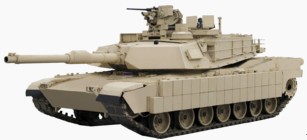
| M1 Abrams | |
|
M1A2 Abrams with prototype TUSK equipment (and optional roof mounted remote control .50 machine gun) Front ·Rear |
|
| Type | Main battle tank |
| Place of origin | United States |
| Service history | |
| In service | 1980–present |
| Used by |
U.S. Army, U.S. Marines, Australia, Egypt, Iraq, Kuwait, Saudi Arabia See Operators below |
| Wars |
Persian Gulf War War in Afghanistan Iraq War 2011 Egyptian revolution |
| Production history | |
| Designer | Chrysler Defense (now General Dynamics Land Systems) |
| Designed | 1972–1979 |
| Manufacturer |
Lima Army Tank Plant (since 1980)[1] Detroit Arsenal Tank Plant (1982–1996) |
| Unit cost | US$6.21 million (M1A2 / FY99)[3] Estimated in 2012 as US$8.58 million (with inflation adjustment) |
| Produced | 1979–present |
| Number built | 9,000+[2] |
| Variants | See variants |
| Specifications | |
| Weight | 67.6 short tons (60.4 long tons; 61.3 t) |
| Length |
Gun forward: 32.04 ft (9.77 m)[4] Hull length: 26.02 ft (7.93 m) |
| Width | 12 ft (3.66 m)[4] |
| Height | 8 ft (2.44 m)[4] |
| Crew | 4 (commander, gunner, loader, driver) |
|
|
|
| Armor |
Chobham, RH armor, depleted uranium strike plates, Kevlar mesh[citation needed] M1: Hull & turret - 350 mm vs APFSDS, 700 mm vs HEAT[5][nb 1] M1A1: Hull & turret - 600 mm vs APFSDS, 700 mm vs HEAT[6] M1A1HA: Hull - 600 mm vs APFSDS, 700 mm vs HEAT, Turret - 800 mm vs APFSDS, 1,300 mm vs HEAT[6][7][nb 2] M1A2: Hull (turret) - 600 (780 mm) mm vs APFSDS, 800 mm (1,060 mm) vs HEAT[8][not in citation given] |
|
Main armament |
105 mm L52 M68 rifled cannon (M1) 120 mm L44 M256 smoothbore cannon (M1A1, M1A2, M1A2SEP) with 42 rounds |
|
Secondary armament |
1 × .50-caliber (12.7 mm) M2HB heavy machine gun with 900 rounds 2 × 7.62 mm (.308) M240 machine guns with 8,800 rounds (1 pintle-mounted, 1 coaxial) |
| Engine |
Honeywell AGT1500C multi-fuel turbine engine 1,500 shp (1,120 kW) |
| Power/weight | 24.5 hp/t (18.27 kW/t) |
| Transmission | Allison DDA X-1100-3B |
| Suspension | Torsion bar |
| Ground clearance |
0.48 m (1 ft 7 in) (M1, M1A1) 0.43 m (1 ft 5 in) (M1A2) |
| Fuel capacity | 500 US gallons (1,900 l; 420 imp gal) |
|
Operational range |
M1A2: 426 km (265 mi)[9] |
| Speed |
M1A2: Road 56 km/h (35 mph) Off-road: 40 km/h (25 mph)[9] |
The M1 Abrams is a third-generation main battle tank produced in the United States. It is named after General Creighton Abrams, former Army Chief of Staff and Commander of US military forces in Vietnam from 1968 to 1972. Highly mobile, designed for modern armored ground warfare,[10] the M1 is well armed and heavily armored. Notable features include the use of a powerful gas turbine engine (multifuel capable, usually fueled with JP8 jet fuel), the adoption of sophisticated composite armor, and separate ammunition storage in a blow-out compartment for crew safety. Weighing nearly 68 short tons (almost 62 metric tons), it is one of the heaviest main battle tanks in service.
The M1 Abrams entered U.S. service in 1980, replacing the M60 tank.[11] It served for over a decade alongside the improved M60A3, which had entered service in 1978. The M1 remains the principal main battle tank of the United States Army and Marine Corps, and the armies of Egypt, Kuwait, Saudi Arabia, Australia, and Iraq.
Three main versions of the M1 Abrams have been deployed, the M1, M1A1, and M1A2, incorporating improved armament, protection and electronics. These improvements, as well as periodic upgrades to older tanks, have allowed this long-serving vehicle to remain in front-line service. The M1A3 is currently under development.[12]
History
The M1 Abrams was developed during the Cold War as a successor to the canceled MBT-70. The M1 Abrams contract went to Chrysler Defense and was the first vehicle to adopt Chobham armor. Adaptations before the Gulf War (Operations Desert Shield and Desert Storm) gave the vehicle better firepower and NBC protection. Being vastly superior to Iraqi tanks, very few M1 tanks were hit by enemy fire. Upgrades after the war improved the tank's weapons sights and fire control unit. The invasion of Iraq in 2003 destroyed Iraq's military. The subsequent insurgency exposed the tanks' vulnerability to rocket-propelled grenades and mines. These problems were partially rectified with the TUSK kit. The Marine Corps sent a company of M1 Abrams to Afghanistan in late 2010.
Development
The first attempt to replace the aging M60 tank was the MBT-70, developed in partnership with West Germany in the 1960s. The MBT-70 had advanced features such as a height-adjustable pneumatic suspension and a turret design that allowed the driver to always face the direction of travel, but ultimately proved to be too heavy, complex, and expensive. As a result of the imminent failure of this project, the U.S. Army introduced the XM803. This succeeded only in producing an expensive system with capabilities similar to the M60.[13]
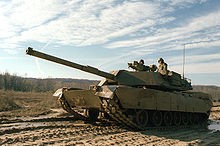
An XM1 Abrams, during a demonstration at Fort Knox, Kentucky in 1979
Congress canceled the MBT-70 in November and XM803 December 1971, and redistributed the funds to the new XM815, later renamed the XM1 Abrams after General Creighton Abrams. Prototypes were delivered in 1976 by Chrysler Defense and General Motors armed with the license-built version of the 105 mm Royal Ordnance L7 gun along with a Leopard 2 for comparison. The turbine-powered Chrysler Defense design was selected for development as the M1; Chrysler had significant experience designing turbine-powered land vehicles going back to the 1950s. In March 1982, General Dynamics Land Systems Division (GDLS) purchased Chrysler Defense, after Chrysler built over 1,000 M1s.[citation needed]
3,273 M1 Abrams were produced 1979-85 and first entered US Army service in 1980. Production at the government-owned, GDLS-operated Lima Army Tank Plant in Lima, Ohio, was joined by vehicles built at the Detroit Arsenal Tank Plant in Warren, Michigan from 1982 to 1996.[1] The M1 was armed with the license-built version of the 105 mm Royal Ordnance L7 gun. An improved model called the M1IP was produced briefly in 1984 and contained small upgrades. The M1IP models were used in the Canadian Army Trophy NATO tank gunnery competition in 1985 and 1987.

105-mm M1 Abrams tank of the 11th Armored Cavalry Regiment at Grafenwöhr Training Area in Germany, 1986
About 6,000 M1A1 Abrams were produced from 1986–92 and featured the M256 120 mm (4.7 in) smoothbore cannon developed by Rheinmetall AG of Germany for the Leopard 2, improved armor, and a CBRN protection system. Production of M1 and M1A1 tanks totaled some 9,000 tanks at a cost of approximately $4.30 million per unit.[2] By 1999 costs for the tank were upwards of US$5 million a vehicle.[3]
In 1990, Project on Government Oversight in a report criticized the M1's high costs and low fuel efficiency in comparison with other tanks of similar power and effectiveness such as the Leopard 2. The report was based on data from U.S. Army sources and the Congressional record.[14]
As the Abrams entered service in the 1980s, they operated alongside M60A3 within the United States military, and with other NATO tanks in numerous Cold War exercises. These exercises usually took place in Western Europe, especially West Germany, but also in some other countries, including South Korea. The exercises were aimed at countering Soviet forces. However, by January 1991 the Berlin Wall had fallen and the Abrams was instead employed in the Middle East.
Gulf War, 1991
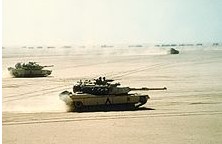
Abrams move out on a mission during Desert Storm in 1991. A Bradley IFV and logistics convoy can be seen in the background.
The Abrams remained untested in combat until the Gulf War in 1991 during Operation Desert Storm. A total of 1,848 M1A1s were deployed to Saudi Arabia to participate in the liberation of Kuwait. The M1A1 was superior to Iraq's Soviet-era T-55 and T-62 tanks, as well as T-72s imported from the Soviet Union and Poland.[15] The existence of licence-produced T-72 (nicknamed Asad Babil) has been disputed; according to Polish officials none were finished prior to the Iraqi Taji tank plant being destroyed in 1991.[15] The T-72s, like most Soviet export designs, lacked night vision systems and then-modern rangefinders, though they did have some night fighting tanks with older active infrared systems or floodlights. A total of 23 M1A1s were damaged or destroyed during the war. Of the nine Abrams destroyed, seven were destroyed by friendly fire, and two were purposely destroyed to prevent capture after being damaged.[16] Some others took minor combat damage, with little effect on their operational readiness. Very few M1 tanks were hit by enemy fire, and there was only one fatality, along with a handful of woundings as a result.
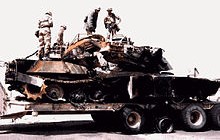
An M1A1 of 2nd Squadron, 11th Armored Cavalry Regiment "Eaglehorse" damaged during an ammunition explosion accident in Camp Doha, Kuwait on 11 July, 1991.[17]
The M1A1 was capable of making kills at ranges in excess of 2,500 metres (8,200 ft). This range was crucial in combat against previous generation tanks of Soviet design in Desert Storm, as the effective range of the main gun in the Soviet/Iraqi tanks was less than 2,000 metres (6,600 ft). This meant Abrams tanks could hit Iraqi tanks before the enemy got in range—a decisive advantage in this kind of combat. In friendly fire incidents, the front armor and fore side turret armor survived direct APFSDS hits from other M1A1s. This was not the case for the side armor of the hull and the rear armor of the turret, as both areas were penetrated at least in two occasions by friendly depleted uranium ammunition during the Battle of Norfolk.[18]
During Operations Desert Shield and Desert Storm some M1IP and M1A1s were modified locally in theater by a modified work order with additional rolled homogenous armor plating being welded directly on the turret front. The M1 can be equipped with mine plow and mine roller attachments.
Upgrades
The M1A2 was a further improvement of the M1A1 with a commander's independent thermal viewer, weapon station, position navigation equipment, and a full set of controls and displays linked by a digital data bus. These upgrades also provided the M1A2 with an improved fire control system.[19] The M1A2 System Enhancement Package (SEP) added digital maps, FBCB2 capabilities, and an improved cooling system to compensate for heat generated by the additional computer systems. The M1A2 SEP also serves as the basis for the M104 Wolverine heavy assault bridge.
Further upgrades included depleted uranium armor for all variants, a system overhaul that returns all A1s to like-new condition (M1A1 AIM), a digital enhancement package for the A1 (M1A1D), and a commonality program to standardize parts between the U.S. Army and the Marine Corps (M1A1HC).
Iraq War
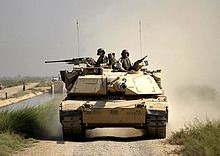
M1A1 conducts reconnaissance in Iraq in September 2004.
Further combat was seen during 2003 when US forces invaded Iraq and deposed the Iraqi leader Saddam Hussein in Iraq War during Operation Iraqi Freedom. As of March 2005, approximately 80 Abrams tanks were forced out of action by enemy attacks.[20]
The most lopsided achievement of the M1A1s was the destruction of seven T-72s in a point-blank skirmish (less than 50 yards (46 m)) near Mahmoudiyah, about 18 miles (29 km) south of Baghdad, with no losses for the American side.[21] In addition to the Abrams' already heavy armament, some crews were also issued M136 AT4 shoulder-fired anti-tank weapons under the assumption that they might have to engage heavy armor in tight urban areas where the main gun could not be brought to bear.
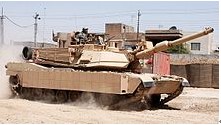
U.S. Army M1A2 Abrams with TUSK equipment
Following lessons learned in Desert Storm, the Abrams and many other US combat vehicles used in the conflict were fitted with Combat Identification Panels to reduce friendly fire incidents. These were fitted on the sides and rear of the turret, with flat panels equipped with a four-cornered 'box' image on either side of the turret front (as seen in the images at right). Some Abrams were also fitted with a secondary storage bin on the back of the existing bustle rack on the rear of the turret referred to as a bustle rack extension to enable the crew to carry more supplies and personal belongings.
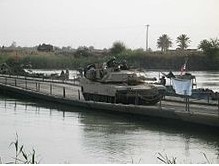
Abrams crossing the Euphrates River at Objective Peach on ribbon assault float bridge deployed by the 299th Engineer Company in 2003
Several Abrams that were irrecoverable due to loss of mobility or other circumstances were destroyed by friendly forces to prevent their capture, usually by other Abrams.[22] Some Abrams were disabled by Iraqi infantrymen in ambushes during the invasion. Some troops employed short-range anti-tank rockets and fired at the tracks, rear and top. Other tanks were put out of action when struck in critical places by heavy machine gun rounds.[23][24] A majority of Abrams damaged post-invasion were by improvised explosive devices (IEDs).[25]
Due to the vulnerability of tanks in urban combat, the Tank Urban Survival Kit, or TUSK, is being issued to some M1 Abrams. It adds protection in the rear and side of the tank to improve fighting ability in urban environments.[26]
In May 2008, it was reported that an American M1 tank had also been damaged by an RPG-29, which uses a tandem-charge high explosive anti-tank warhead to penetrate explosive reactive armor (ERA) as well as composite armor behind it, in Iraq.[27][28] The US considers the RPG-29 threat to American armor high and has refused to allow the newly formed Iraqi army to buy it, fearing it will fall into the insurgent hands.[29]
Afghanistan
Operating tanks in Afghanistan can be difficult due to the rough terrain, although Canada and Denmark have deployed Leopard 1 and 2 battle tanks that have been specifically modified to operate in the relatively flat and arid conditions of south-western Afghanistan. In late 2010 at the request of Regional Command Southwest, the US Marine Corps deployed a small detachment of 14 M1A1 Abrams from Delta Company, 1st Tank Battalion, 1st Marine Division (Forward),[30] to southern Afghanistan in support of operations in Helmand and Kandahar provinces.[31]
Future
The tracked M8 Armored Gun System was conceived as a possible supplement for the Abrams in U.S. service for low-intensity conflict in the early 1990s. Prototypes were made but the program was canceled. The 8-wheeled M1128 Mobile Gun System was designed to supplement the Abrams in U.S. service for low-intensity conflict.[32] It has been introduced into service.
The U.S. Army's Future Combat Systems' XM1202 Mounted Combat System was to replace the Abrams in U.S. service and was in development when funding for the program was cut from the DoD's budget.
The M1A3 Abrams is in the early design period with the U.S. Army.[12][33] The Army aims to build prototypes by 2014 and to begin to field the first combat-ready M1A3s by 2018 or 2019.
The M1A2 SEP TUSK Abrams and a modernized M1 Abrams were included in the Ground Combat Vehicle (GCV) Analysis of Alternatives (AOA). Vehicles included in the AOA were determined to be inferior to the planned GCV.[34] The U.S. Army Vice Chief of Staff Gen. Peter Chiarelli commended the M1 Abrams program and recommended a similar approach for the GCV program.[35] The Ground Combat Vehicle family of vehicles is the planned successor to the M1 as well as many other U.S. Army vehicles. However, the Army anticipates that the M1A1 will remain in U.S. service until at least 2021, and the M1A2 to beyond 2050.[36]
Plant shutdown
The Army is planning to close the Lima Army Tank Plant from 2013 to 2016 in an effort to save over $1 billion; it would be reopened in 2017 to upgrade existing tanks. General Dynamics Land Systems (GDLS), which operates the factory, opposed the closure, arguing that suspension of operations would increase long-term costs and reduce flexibility.[37][38] Specifically, GDLS estimates that closing the plant would cost $380 million and restarting production would cost $1.3 billion.[39] If passed, a bill in the U.S. Senate from the first session of the 112th Congress would allocate $272 million in funds toward the plant to allow it to continue regular operations through 2013.[40]
Design
Countermeasures
Camouflage
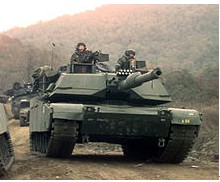
M1A1s during Foal Eagle '98 training exercises in South Korea, with their factory single green paint scheme.
M1A1 in Australian Army Disruptive Pattern Camouflage for vehicles and materiel. Smoke grenade launchers seen at left.
Unlike earlier US military vehicles from World War II through Vietnam, which used a scheme of dark brownish green known as "olive drab" with large white stars, prototypes and early production M1 (105 mm gun) & M1-IP models used the flat medium green paint; and the large white insignia stars have transitioned to much smaller black markings. Some units painted their M1s with the older MERDC 4-color paint scheme but the turn-in requirements for these tanks required repainting them to solid green. Therefore, even though a large number of the base model M1s were camouflaged in the field, few or none exist today.
M1A1s came from the factory with the NATO three color camouflage Black/Med-Green/Dark-Brown CARC paint jobs.[citation needed] Today M1A1s are given the NATO three color paint job during rebuilds. M1s and M1A1s deployed to Desert Storm were hastily painted desert tan. Some, but not all, of these tanks were re-painted to their "authorized" paint scheme. M1A2s built for Middle Eastern countries were painted in desert tan. Some M1 series tanks are being painted desert tan for service in Iraq and some are not. Replacement parts (roadwheels, armor skirt panels, drive sprockets, etc.) are painted overall green, which can sometimes lead to vehicles with a patchwork of green and desert tan parts.
Australian M1A1s were desert tan when delivered but have undergone a transition to the Australian Army vehicle standard 'Disruptive Pattern Camouflage'; a scheme that consist of black, olive drab and brown.[41][42]
[edit] Concealment
The turret is fitted with two six-barreled smoke grenade launchers (USMC M1A1s use an eight-barreled version). These can create a thick smoke that blocks both vision and thermal imaging. The engine is also equipped with a smoke generator that is triggered by the driver. When activated, fuel is sprayed into the hot turbine exhaust, creating the thick smoke. However, due to change from diesel as a primary fuel to the use of JP-8, this system is disabled on most Abrams today because of a slightly elevated risk of fire damage to the engine compartment.
Active protection system
In addition to the armor, some Abrams are equipped with a Softkill Active protection system, the AN/VLQ-6 Missile Countermeasure Device (MCD) that can impede the function of guidance systems of some semi-active control line-of-sight (SACLOS) wire and radio guided anti-tank missiles (such as the Russian AT-3, AT-4, AT-5, AT-6 and the like) and thermally and infrared guided missiles.[43] The MCD works by emitting a massive, condensed infrared signal to confuse the seeker of an anti-tank guided missile (ATGM). However, the drawback to the system is that the ATGM is not destroyed, it is merely directed away from its intended target, leaving the missile to detonate elsewhere. This device is mounted on the turret roof in front of the loader's hatch, and can lead some people to mistake Abrams fitted with these devices for the M1A2 version, since the Commander's Independent Thermal Viewer on the latter is mounted in the same place, though the MCD is box-shaped and fixed in place as opposed to cylindrical and rotating like the CITV.
Armor
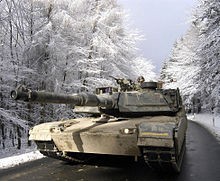
Tankers drive an M1A1 Abrams through the Taunus Mountains north of Frankfurt during Exercise Ready Crucible in February, 2005.
The Abrams is protected by armor based on the British-designed Chobham armor, a further development of the British 'Burlington' armor. Chobham is a composite armor formed by spacing multiple layers of various alloys of steel, ceramics, plastic composites, and kevlar, giving an estimated maximum (frontal turret) 1,320–1,620 millimetres (52–64 in) of RHAe versus HEAT (and other chemical energy rounds) and 940–960 mm (37–38 in) versus kinetic energy penetrators.[44] It may also be fitted with reactive armor over the track skirts if needed (as in the Urban Survival Kit) and slat armor over the rear of the tank and rear fuel cells to protect against ATGMs. Protection against spalling is provided by a Kevlar liner. Beginning in 1987, M1A1 tanks received improved armor packages that incorporated depleted uranium (DU) mesh[citation needed] in their armor at the front of the turret and the front of the hull. Armor reinforced in this manner offers significantly increased resistance towards all types of anti-tank weaponry, but at the expense of adding considerable weight to the tank, as depleted uranium is 1.7 times more dense than lead.[45]
The first M1A1 tanks to receive this upgrade were tanks stationed in Germany, since they were the first line of defense against the Soviet Union. US-based tank battalions participating in Operation Desert Storm received an emergency program to upgrade their tanks with depleted uranium armor immediately before the onset of the campaign. M1A2 tanks uniformly incorporate depleted uranium armor, and all M1A1 tanks in active service have been upgraded to this standard as well. The added protection from the depleted uranium armor is believed to be equivalent to 24 inches (610 mm) of RHA. In the Gulf War, Abrams tanks survived multiple hits at relatively close ranges from Iraqi Lion of Babylon tanks and ATGMs. M829A1 "Silver Bullet" APFSDS rounds from other M1A1 Abrams were unable to penetrate the front and side armor (even at close ranges) in friendly fire incidents as well as an incident in which an Abrams tried to destroy an abandoned Abrams stuck in the mud.[46]
Damage control
If the Abrams does suffer damage resulting in a fire in the crew compartment, the tank is equipped with a halon fire-suppression system that automatically engages and extinguishes fires in seconds. The engine compartment is equipped with a second fire-suppression system which is engaged by pulling a T-handle located on the left side of the hull. In addition, several small hand-held fire extinguishers are located in the crew compartment.
Fuel and ammunition are in armored compartments with blowout panels to protect the crew from the risk of the tank's own ammunition cooking off if the tank is damaged. It once saved a crew in Iraq war, according to Jane's Weekly 20 June 2003.[verification needed][clarification needed]
Armament
Primary
M68A1 rifled gun
The main armament of the original model M1 was the M68A1 105 mm rifled tank gun firing a variety of high explosive anti-tank, high explosive, white phosphorus and an anti-personnel (multiple flechette) round. This gun is a license-built version of the British Royal Ordnance L7 gun. However, it proved to be inadequate; a cannon with lethality beyond the 3-kilometer (1.9 mi) range was needed to combat newer armor technologies. To attain that lethality, projectile diameter needed to be increased.
The main armament of the original model M1 was the M68A1 105 mm rifled tank gun firing a variety of high explosive anti-tank, high explosive, white phosphorus and an anti-personnel (multiple flechette) round. This gun is a license-built version of the British Royal Ordnance L7 gun. However, it proved to be inadequate; a cannon with lethality beyond the 3-kilometer (1.9 mi) range was needed to combat newer armor technologies. To attain that lethality, projectile diameter needed to be increased.
M256 smoothbore gun
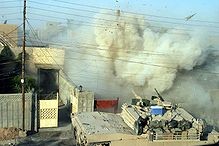
A Marine M1A1 Abrams fires its main gun into a house providing suppressive counter fire against insurgents in Fallujah, Al Anbar Province, Iraq during the Second Battle of Fallujah, 2004.
The main armament of the M1A1 and M1A2 is the M256A1 120 mm smoothbore gun, designed by Rheinmetall AG of Germany, manufactured under license in the United States by Watervliet Arsenal, New York. The M256A1 is a variant of the Rheinmetall 120 mm L/44 gun carried on the German Leopard 2 on all variants up to the Leopard 2A5. Leopard 2A6 replaced the L/44 barrel with a longer L/55.
The M256A1 fires a variety of rounds. The M829A2 APFSDS round was developed specifically to address the improved protection of a Russian T-72, T-80U or T-90 main battle tank equipped with Kontakt-5 Explosive Reactive Armor.[47] Later, the M829A3 APFSDS round was introduced to improve its effectiveness against next generation ERA equipped tanks. As a counter to that, the Russian army introduced Relikt, the most modern Russian ERA, which is claimed to be twice as effective as Kontakt-5.[48] Development of the M829 series is continuing with the M829E4 currently in development.[49] The Abrams also fires HEAT shaped charge rounds such as the M830, the latest version of which (M830A1) incorporates a sophisticated multi-mode electronic sensing fuse and more fragmentation which allows it to be used effectively against armored vehicles, personnel, and low-flying aircraft. The Abrams uses a manual loader. The fourth tank crew member on the Abrams also provides additional support for maintenance, observation post/listening post (LP/OP) operations, and other tasks.
The new M1028 120 mm anti-personnel canister cartridge was brought into service early for use in the aftermath of the 2003 invasion of Iraq. It contains 1,098 3⁄8-inch (9.5 mm) tungsten balls which spread from the muzzle to produce a shotgun effect lethal out to 600 meters (2,000 ft). The tungsten balls can be used to clear enemy dismounts, break up hasty ambush sites in urban areas, clear defiles, stop infantry attacks and counter-attacks and support friendly infantry assaults by providing covering fire. The canister round is also a highly effective breaching round and can level cinder block walls and knock man-sized holes in reinforced concrete walls for infantry raids at distances up to 75 meters (246 ft).[50]
In addition to this, the XM1111 (Mid-Range-Munition Chemical Energy) is also in development. The XM1111 is a guided munition using a dual-mode seeker that combines imaging-infrared and semi-active laser guidance. The MRM-CE was selected over the competing MRM-KE which used a rocket-assisted kinetic energy penetrator. The CE variant was chosen due to its better effects against secondary targets, providing a more versatile weapon. The Army hopes to achieve IOC with the XM1111 by 2013.[51]
Secondary
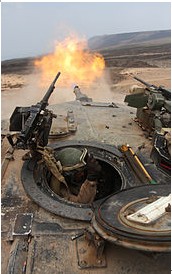
M1A1 firing its main gun as seen from the loader's hatch, the M240 is visible left while the M2HB is visible right
The Abrams tank has three machine guns:
1. A .50 cal. (12.7 mm) M2HB machine gun in front of the commander's hatch. On the M1, M1IP and M1A1, this gun is on a powered mount and can be fired using a 3× magnification sight, known as the Commander's Weapon Station (CWS for short), while the vehicle is "buttoned up" with all its hatches closed to protect the crew. On the M1A2 and M1A2 SEP, this gun is on a flex mount, the commander having to expose himself to fire the weapon manually. With the TUSK add-on kit, an M2HB or a Mk 19 grenade launcher can be mounted on a CROWS remote weapons platform (similar to the Protector M151 remote weapon station used on the Stryker family of vehicles).
However current variants of the TUSK kit on the M1A2 have forgone this, instead adding transparent gun shields to the commander's weapon station. The upgrade variant called M1A1 Abrams Integrated Management (AIM) equips the .50 caliber gun with a thermal sight for accurate night and other low-visibility shooting.[52]
However current variants of the TUSK kit on the M1A2 have forgone this, instead adding transparent gun shields to the commander's weapon station. The upgrade variant called M1A1 Abrams Integrated Management (AIM) equips the .50 caliber gun with a thermal sight for accurate night and other low-visibility shooting.[52]
2. A 7.62 mm M240 machine gun in front of the loader's hatch on a skate mount (seen at right). Some of these have been fitted with gun shields during the Iraq War, as well as night-vision scopes for low-visibility engagements.
3. A second 7.62 mm M240 machine gun in a coaxial mount to the right of the main gun. The coaxial MG is aimed and fired with the same computer fire control system used for the main gun.[53]
4. (Optional) A second coaxial 12.7 mm M2HB machine gun can be mounted directly above the main gun in a remote weapons platform as part of the TUSK upgrade kit.
Aiming
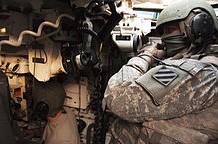
A view of the gunner's station (bottom left) and commander's station (top right)
The Abrams is equipped with a ballistic fire-control computer that uses user and system-supplied data from a variety of sources, to compute, display, and incorporate the three components of a ballistic solution—lead angle, ammunition type, and range to the target—to accurately fire the tank. These three components are determined using a YAG rod laser rangefinder, crosswind sensor, a pendulum static cant sensor, data concerning performance and flight characteristics of each specific type of round, tank-specific boresight alignment data, ammunition temperature, air temperature, barometric pressure, a muzzle reference system (MRS) that determines and compensates for barrel droop at the muzzle due to gravitational pull and barrel heating due to firing or sunlight, and target speed determined by tracking rate tachometers in the Gunner's or Commander's Controls Handles. All of these factors are computed into a ballistic solution and updated 30 times per second. The updated solution is displayed in the Gunner's or Tank Commander's field of view in the form of a reticle in both day and Thermal modes. The ballistic computer manipulates the turret and a complex arrangement of mirrors so that all one has to do is keep the reticle on the target and fire to achieve a hit. Proper lead and gun tube elevation are applied to the turret by the computer, greatly simplifying the job of the gunner.[citation needed]
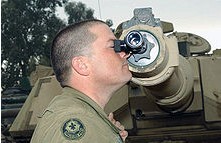
2nd Armored Cavalry Regiment soldier, assisting in the critical job of "boresighting" the alignment of all the tank's sights to the center of the axis of the bore of the main gun on an M1A1 Abrams in Mosul, Iraq in January 2005. Hand signals enable the gunner (inside the tank) to train the main gun onto a boresighting target.
The fire-control system uses these data to compute a firing solution for the gunner. The ballistic solution generated ensures a hit percentage greater than 95 percent at nominal ranges.[citation needed] Either the commander or gunner can fire the main gun.
Additionally, the Commander's Independent Thermal Viewer (CITV) on the M1A2 can be used to locate targets and pass them on for the gunner to engage while the commander scans for new targets. In the event of a malfunction or damage to the primary sight system, the main and coaxial weapons can be manually aimed using a telescopic scope boresighted to the main gun known as the Gunner's
Auxiliary Sight (GAS). The GAS has two interchangeable reticles; one for HEAT and MPAT (MultiPurpose AntiTank) rounds and one for
APFSDS and STAFF (Smart Target-Activated Fire and Forget) ammunition. Turret traverse and main gun elevation can be accomplished with manual handles and cranks in the event of a Fire Control System or Hydraulic System failure. The commander's M2 .50 caliber machine gun on the M1 and M1A1 is aimed by a 3× magnification sight incorporated into the Commander's Weapon Station (CWS), while the M1A2 uses either the machine gun's own iron sights, or a remote aiming system such as the CROWS system when used as part of the TUSK (Tank Urban Survival Kit). The loader's M240 machine gun is aimed either with the built-in iron sights or with a thermal scope mounted on the machine gun.[citation needed]
Additionally, the Commander's Independent Thermal Viewer (CITV) on the M1A2 can be used to locate targets and pass them on for the gunner to engage while the commander scans for new targets. In the event of a malfunction or damage to the primary sight system, the main and coaxial weapons can be manually aimed using a telescopic scope boresighted to the main gun known as the Gunner's
Auxiliary Sight (GAS). The GAS has two interchangeable reticles; one for HEAT and MPAT (MultiPurpose AntiTank) rounds and one for
APFSDS and STAFF (Smart Target-Activated Fire and Forget) ammunition. Turret traverse and main gun elevation can be accomplished with manual handles and cranks in the event of a Fire Control System or Hydraulic System failure. The commander's M2 .50 caliber machine gun on the M1 and M1A1 is aimed by a 3× magnification sight incorporated into the Commander's Weapon Station (CWS), while the M1A2 uses either the machine gun's own iron sights, or a remote aiming system such as the CROWS system when used as part of the TUSK (Tank Urban Survival Kit). The loader's M240 machine gun is aimed either with the built-in iron sights or with a thermal scope mounted on the machine gun.[citation needed]
Mobility
Tactical
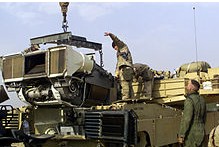
Marines from 1st Tank Battalion load a Honeywell AGT1500 multi-fuel turbine back into the tank at Camp Coyote, Kuwait, February 2003.
The M1 Abrams is powered by a 1,500 shaft horsepower (1,100 kW) Honeywell AGT 1500 (originally made by Lycoming) multi-fuel gas turbine, and a six speed (four forward, two reverse) Allison X-1100-3B Hydro-Kinetic automatic transmission, giving it a governed top speed of 45 mph (72 km/h) on paved roads, and 30 mph (48 km/h) cross-country. With the engine governor removed, speeds of around 60 mph (97 km/h) are possible on an improved surface; however, damage to the drive train (especially to the tracks) and an increased risk of injuries to the crew can occur at speeds above 45 mph (72 km/h). The tank was built around this engine[54] and it is multifuel capable; meaning that it can be powered with diesel, kerosene, any grade of motor gasoline, and jet fuel (such as JP-4 or JP-8). For logistical reasons, JP-8 is the US military's universal fuel powering both aircraft and vehicle fleets. On the other hand, Australian M1A1 AIM SA burn diesel fuel, since the use of JP-8 is less common in the Australian Army.
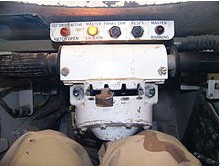
Driving controls
The gas turbine propulsion system has proven quite reliable in practice and combat, but its high fuel consumption is a serious logistic issue (starting up the turbine alone consumes nearly 10 US gallons (38 L) of fuel).[55] The engine burns more than 1.67 US gallons (6.3 L) per mile (60 US gallons (230 L) per hour) when traveling cross-country and 10 US gallons (38 L) per hour when idle.[56] The high speed, high temperature jet blast emitted from the rear of M1 Abrams tanks makes it difficult for the infantry to proceed shadowing the tank in urban combat.[57] The turbine is very quiet when compared to diesel engines of similar power output and produces a significantly different sound from a contemporary diesel tank engine, reducing the audible distance of the sound, thus earning the Abrams the nickname "whispering death" during its first REFORGER exercise.
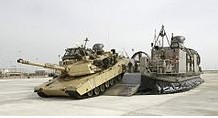
A Marine M1A1 Abrams offloading from Landing Craft Air Cushioned vehicle
Honeywell was developing another gas turbine engine with General Electric for the XM2001 Crusader program that was also to be a replacement for the AGT-1500 engine already in the Abrams tank.[58] The new LV100-5 engine is lighter and smaller (43% fewer parts) with rapid acceleration, quieter running and no visible exhaust.[59] It also features a 33% reduction in fuel consumption (50% less when idle) and near drop-in replacement.[60] The Abrams-Crusader Common Engine Program was shelved when the Crusader program was canceled, however Phase 2 of Army's PROSE (Partnership for Reduced O&S Costs, Engine) program calls for further development of the LV100-5 and replacement of the current AGT-1500 engine.[61]
Using a high power density 330 cc (20 cu in) Wankel rotary engine modified to use diesel and military grade jet fuel, TARDEC developed a 220-pound (100 kg) Auxiliary Power Unit designed to fit into the M1 Abrams, replacing an existing battery pack that weighs about 500 pounds (230 kg). The new APU will also be more fuel efficient than the tank's main engine.[62] Testing of the first APUs began in 2009.
Marine M1A1 fitted with snorkel attachment and bustle rack extension.
Although the M1 tank is not designed to carry riders easily, provisions exist for the Abrams to transport troops in tank desant with the turret stabilization device switched off. A battle equipped infantry squad may ride on the rear of the tank, behind the turret. The soldiers can use ropes and equipment straps to provide handholds and snap links to secure themselves. If and when enemy contact is made, the tank conceals itself allowing the infantry to dismount.[63]
Strategic
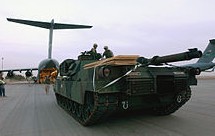
A U.S. Army M1A1 after being offloaded from a US Air Force C-17 at Balad Air Base, Iraq in 2004.
Strategic mobility is the ability of the tanks of an armed force to arrive in a timely, cost effective, and synchronized fashion. The Abrams can be carried by a C-5 Galaxy or a C-17 Globemaster III. The limited capacity (two combat-ready in a C-5, one combat-ready tank in a C-17) caused serious logistical problems when deploying the tanks for the first Persian Gulf War, though there was enough time for 1,848 tanks to be transported by ship.
Marines transport their MAGTF-attached Abrams by combat ship. A Wasp-class LHD typically carries a company of 4 to 5 tanks attached to the deployed Marine Expeditionary Unit, which are then amphibiously transported to shore by LCAC at 1 combat-ready tank per landing craft.
The Abrams is also transportable by truck, namely the M1070 Heavy Equipment Transporter (HET). The HET can operate on highways, secondary roads, and cross-country. The HET accommodates the 4 tank crewmen.[64]
The first instance of the Abrams being airlifted directly into a battlefield occurred in April 2003, when armored elements of the 1st Infantry Division were lifted by C-17s into northern Iraq from Ramstein, Germany to support Task Force Viking.[65]
Share this page



















